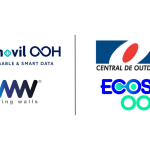By Ron Graham, an independent consultant for OOH media and an advisor to OAAM

Technology and data continue to dominate the Out of Home (OOH) advertising media industry and along with it comes change, challenges and opportunities. The most immediate problem for OOH and Digital OOH is automation. It is the pipeline that connects and manages the flow of data, in the media buying and selling, between Demand-Side Platforms and Supply-Side Platforms.
DSPs and SSPs are well established for online, mobile and social media, as are granular audience data, CPM trading and all things programmatic.
Digital out of home (DOOH) is evolving fast, already as a user of technology and starting to move into automation of media trading, largely because the digital media agencies see synergies between online and offline, and that OOH is a great amplifier for digital media.
Traditional OOH is less obviously aligned with digital media but is equally able to enhance the effectiveness of online media campaigns and has the added value to build and sustain brand awareness to support existing demand and stimulate new demand in ways which digital media cannot.

The immediate challenge for OOH and DOOH is automation to connect suppliers with buyers but this also raises other problems to solve, like standardisation and audience metrics.
Two new phrases, recently seen in articles from the world’s Out Of Home (OOH) media associations, (at least new to me), are; Re-Marketer and Audience-Led Selling. Looking further into these definitions, they offer some insight around issues affecting the OOH media segment and are important to understand in relation to the potential for programmatic OOH.
Re-Marketer is a better definition than reseller or broker and to be fair, DSPs and SSPs are not buying then reselling (broking), but they act openly for the sellers and buyers, albeit as 3rd parties – hence the term re-marketer. Note, this is not to be confused with retargeting, which is repeating the same advertising to previously reached audiences.
Remarketer applies to the DSP’s, trading desks, exchanges and programmatic buying channels, as well as the SSP’s which feature supplier media inventory in automated platforms. Their role is to help the actual supplier to sell and assist the ultimate buyer to buy. This is a good thing however it does remind us that there are middlemen in the trading chain, so essentially, re-marketers.
Like all middlemen they should have purpose and add value to justify and monetise their role.
Remarketers are being invited to collaborate in outdoor media associations, to be part of the collective interests of the industry and to promote cooperation among all stakeholders. Given the changes and challenges in the OOH media trading, this is a good move which can only help.
Audience-led Selling is potentially a good thing too, except that it is only part of a whole which has to be understood and appreciated.
Audience-led selling refers to media trading based on impressions – which is how online, mobile and social media is sold. It follows that if OOH and DOOH media seek to be integrated into multi-media campaigns, then it helps to be traded on like-for-like basis. This is however a problem, as outdoor media options in Malaysia struggle to provide impressions data and there is a big difference between OOH impressions compared to online.
The “whole” I am referring to is media planning and buying. In the most developed markets, millions of dollars have been invested in sophisticated audience measurement for out of home media assets. Traffic data only gives indication of the opportunity for exposure. By adding factors, such as size and position of assets, viewing distance, dwell time, competing assets and occupancy of vehicles we can predict the likely-to-see (LTS) audience who will actually see the OOH assets.

Visibility adjustment research further qualifies the different attention and impact, between (for example) large billboards compared to transit station posters. This is a costly option, requiring assessing each individual asset, but provides robust prediction of being seen (eyes-on). Sophisticated modelling is used to provide comparison currency, which is broadly accepted as long as the methodology is reliable and transparent.
The common currency for online media is impressions and it is clear that an impression for online and mobile media is different from OOH. One ad loading on a webpage is one ad impression, (whether or not it is seen), which is an opportunity to be seen (OTS).
This issue is at the heart of a big debate within the Outdoor Advertising Association of America (OAAA), the UK association; Outsmart, and the World OOH Organisation. Some of the leading measurement systems in some of the worlds largest OOH media markets, are out of date and need further investment. The industry got itself into a spin last month, thinking that years of refined measurement of “eyes-on” was going to be abandoned for simpler, OTS measurement. This is not the case. OOH media requires two streams of data, one of which is OTS impressions – which is where “audience-led selling” comes in, the other being planning data.
When impressions are comparable, they can be used as a media trading currency but only in the transaction process.
Not all OOH media can provide predicted impressions, and (I would argue) not all media should be planned on impressions. The skills of the media planner, are to determine the best channels to support the brand goals. There are so many other factors, such as simple geographic distribution, to the value of premium environments like airports, or the relative impact (say) being on a 200 sq mtr billboard vs a 20 sq mtr LED screen at similar location.
OOH remains a highly effective mass reach medium and the one-to-many delivery cannot be aligned with one-to-one, the way online and mobile media are. As a minimum, OOH needs a ‘multiplier’ to reflect many exposures delivered from one showing, which then also needs to be adjusted for time-share on DOOH.
It is clear there is still more to do, before OOH media owners can offer audience-led selling. Equally, OOH media buyers have to consider the ‘whole’ picture, and not pin their hopes on programmatic buying to provide the best results from media investments.
Programmatic – including remarketing and audience-led selling – are part of the new era for OOH and will certainly contribute incremental growth but this is only part of the story. Traditional OOH will remain as a reliable mass-market creator of awareness, building brands and sustaining media presence. Digital OOH opens up new values, such as flexibility yet also leverages classic values such as locality relevance and impact.
The OOH industry has to embrace new challenges without abandoning its old values. This goes for audience measurement too, to seek common impressions data to allow currency of pricing while also using visibility adjusted data to optimise campaign planning and media selection.
Reliable audience metrics and uptake of automation are opportunities for OOH growth, to justify budgets, access new remote media trading and capitalise on business efficiencies.
Measurement and automation are urgent priorities for out of home media, in Malaysia, in order to compete for media budgets and attract new campaign strategies. Until we solve these two factors, programmatic will remain elusive to out of home media owners in this region, regardless of efforts by remarketers or pressure for audience-led selling.
MARKETING Magazine is not responsible for the content of external sites.









